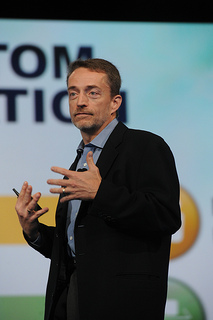SAN FRANCISCO — Only one day into VMworld 2012 and there’s already been a slew of change: VMware Inc. officially changed its CEO, unveiled a cloud software suite and announced it’s getting rid of its vRAM licensing scheme, much to the delight of the 20,000 attendees at the opening keynote.
Paul Maritz (pictured above), who has led the company for the past four years, bid adieu before he starts his next gig at parent EMC Corp. as chief strategist and introduced VMware’s new CEO, Pat Gelsinger, who officially starts the job on Sept. 1. “Fasten your seat belts for the next four years,” said Maritz.
Gelsinger unveiled VMware vCloud Suite 5.1, which integrates the company’s virtualization, cloud infrastructure and management portfolio into a single SKU — aimed at simplifying the adoption of cloud technologies. The new suite is based on an updated version of the VMware vSphere 5.1 virtualization platform, which offers more powerful VMs and more robust networking capabilities. And it’s aimed at any kind of cloud — private clouds or service partners working in public clouds.

This comes at a time when Microsoft Corp. has said it will simplify its licensing in Windows Server 2012, but Jackson denied that had any influence on VMware’s decision to ditch vRAM. “You cannot compete against Microsoft on price — they are the world’s most profitable for-free company ever,” he said. “You compete with Microsoft on value.”
VMware also unveiled Cloud Ops, a set of education and advisory services to help customers transition to a new operating model for cloud computing. Gelsinger said VMware’s recent acquisitions of Nicira and DynamicOps are part of the company’s strategy of working with other vendors’ cloud platforms.
Cloud Ops Forum, a group of consulting and integration partners, will collaborate on further defining this new operating model; launch members include Canopy, Capgemini, CGI, CSC, Dell, Deloitte, EMC, HP, Infosys and T-Systems.
“It’s a multi-cloud world,” said Gelsinger. And while VMware is working toward providing a homogenous environment, “there are other pockets of infrastructure we need to support as well.”
VMware’s Cloud Foundry platform-as-a-service is a first step (it’s currently in beta and will go into production later this year), which will be available on multiple cloud platforms. “Thirty-five partners are taking that technology and putting it on other platforms including Amazon and OpenStack, “ said Maritz.
For Jeff Franz-Lien, manager of infrastructure services with the Manitoba Liquor Control Commission (MLCC), the move to cloud is appealing.
The provincial Crown agency has already virtualized several applications and extended its existing VMware platform to accommodate a new ERP solution. It’s now moved onto “the next black hole for wasted time,” piloting virtualized desktops in four stores with plans for full deployment in all 52 stores within the next few months.
“We’re in the middle of this virtualization process and getting infrastructure transformed,” said Franz-Lien. “We want to know where it’s going next.” He’s planning to take advantage of VMware’s free assessment service to benchmark his current environment and evaluate the future of cloud within his organization. This is of particular interest as MLCC merges with Manitoba Lotteries and is looking to extend virtualization across the merged entities and go through a data centre relocation.
While the myriad announcements at VMworld are appealing, Franz-Lien notes a need for caution. “VMware [NYSE:VMW] is developing a pretty daunting set of apps and services. “I had to come here (to the conference) to find out about the assessment,” he said, adding it’s important that VMware makes all of this information more easily accessible to customers.